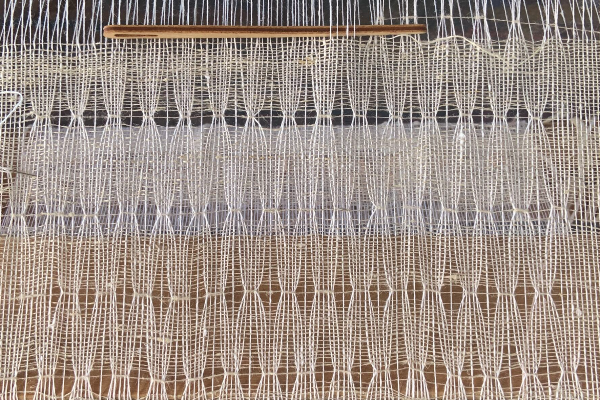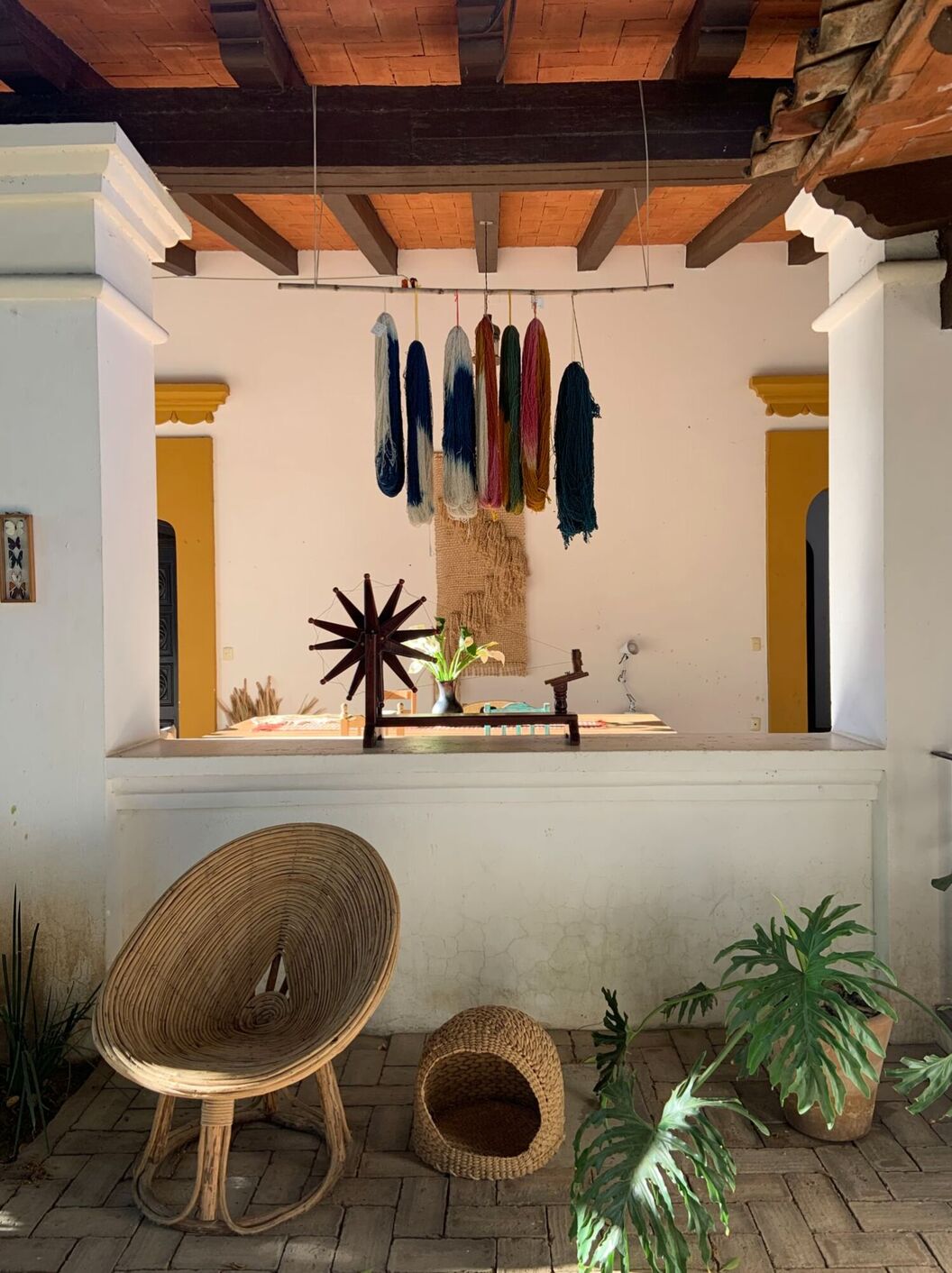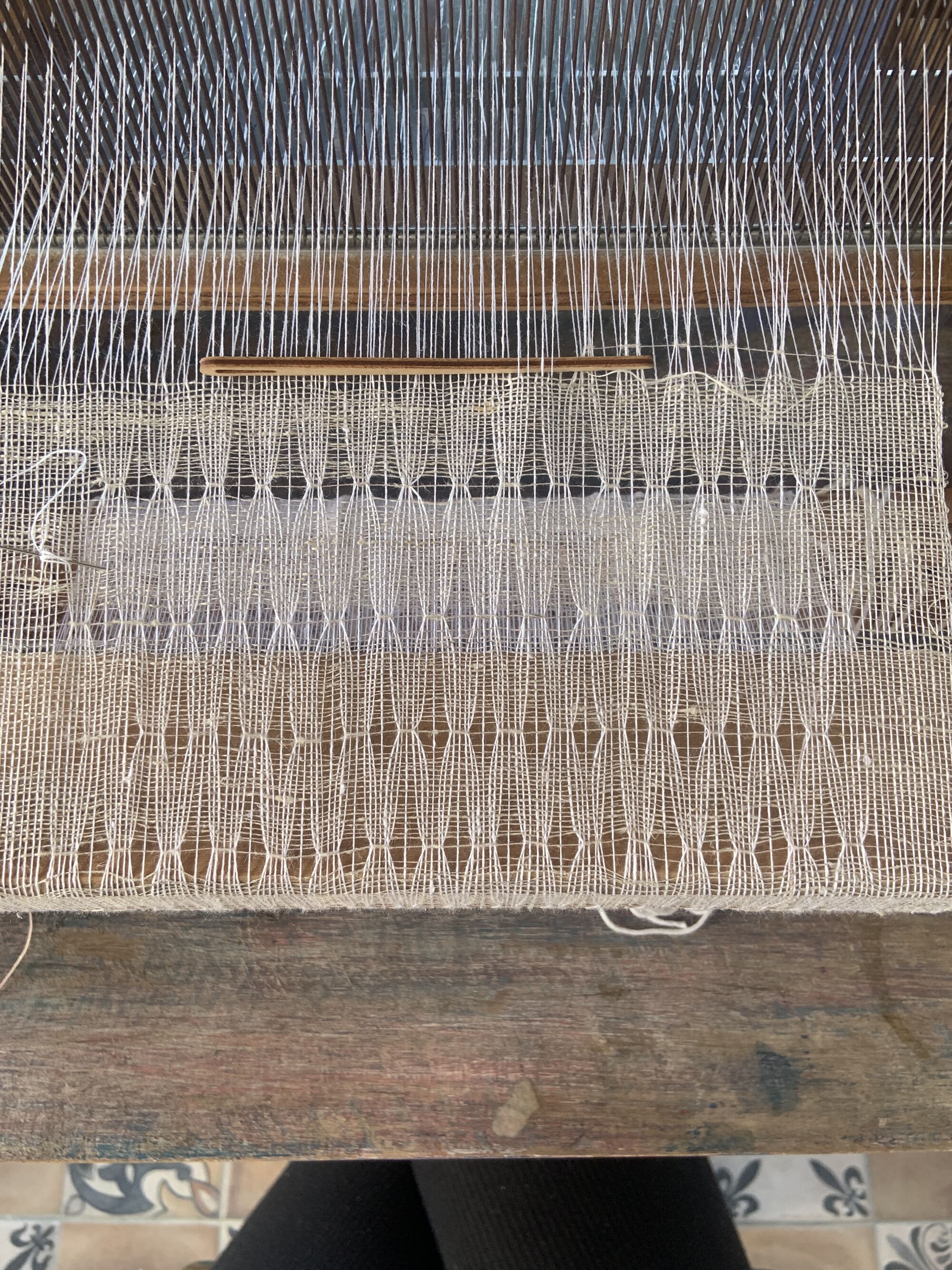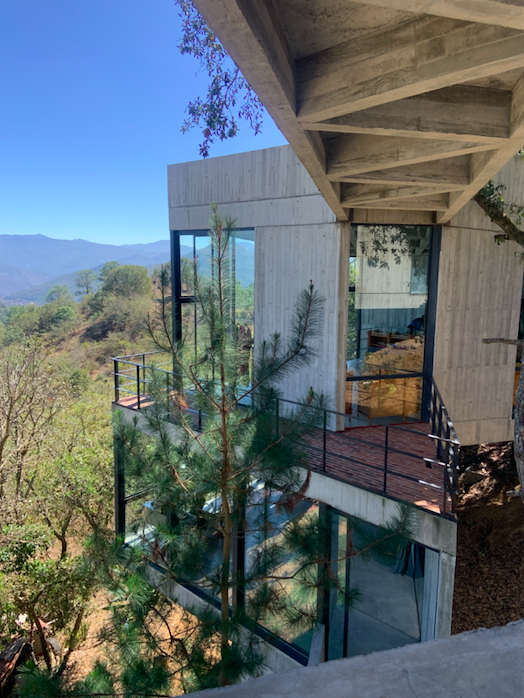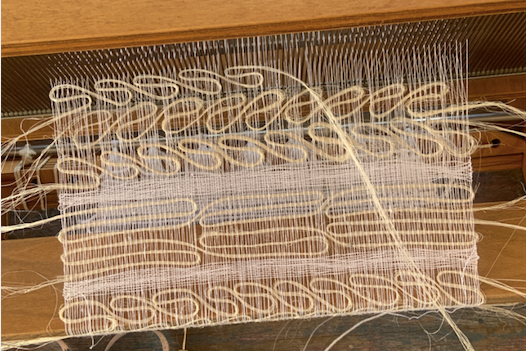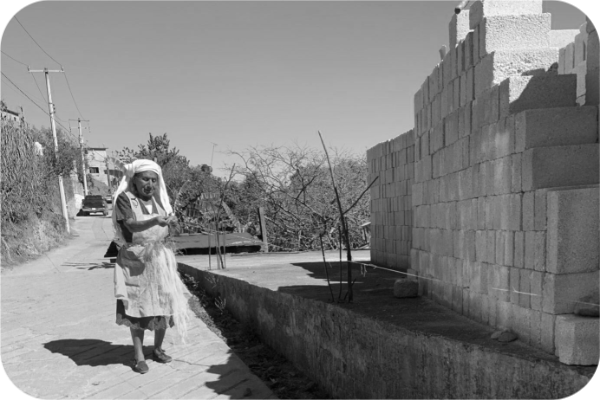Au mois de février, j’ai eu le grand privilège de participer à une résidence chez Texere, à Oaxaca au Mexique. Mon expérience ne pouvait pas être plus positive. La maison qui m’a accueillie est absolument sublime, le coup de foudre était instantanné.
Je ressentais depuis longtemps le besoin de me dégourdir créativement, de sortir de ma zone de confort technique. J’ai donc choisi d’utiliser mon temps là-bas pour explorer la construction de la dentelle, mais, cette fois-ci, de troquer ma vieille machine à tricot pour un métier à tisser. Ça faisait des lunes que je n’avais pas tissé et le défi m’intimidait beaucoup, mais je suis satisfaite d’avoir pris le risque, ma recherche m’a finalement beaucoup inspirée.
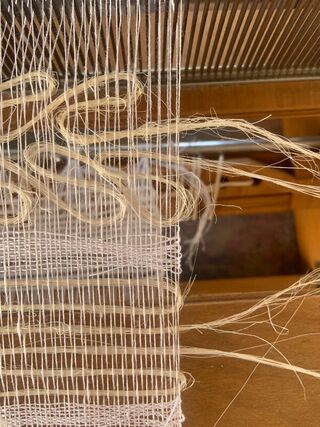
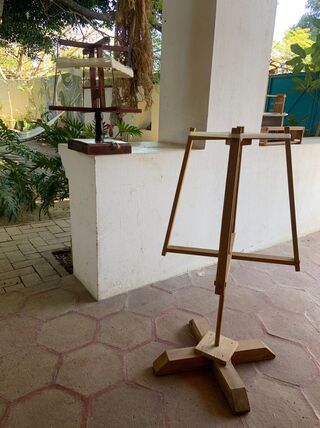
Portraits textiles 1 | 2
la soie de San Pedro Cajonos
J’ai eu la chance d’aller visiter le sanctuaire de sériciculture dans le village San Pedro Cajonos, niché très haut dans les montagnes du désert de Oaxaca, en Sierra Norte. Le projet est absolument inspirant. Bâti il y a quelques années à peine, le sanctuaire est une initiative qui vise à appuyer les producteurs de soie de la région, afin de préserver ce savoir-faire textile traditionnel pratiqué depuis plus de 400 ans.
On y produit la soie de A à Z : de la préservation des oeufs, à l’alimentation des verres, à la récupération des cocons, au traitement du fil, tout est fait sur place. Les producteurs et artisans locaux peuvent venir utiliser les équipements (rouets mécaniques, métiers à tisser, outils pour la teinture des fils, etc.) travailler sur place à leur guise, et peuvent profiter du service d’entreposage et réfrigération des oeufs afin de mieux planifier leur production.
J’ai eu le souffle coupé devant ce processus aussi beau que lent, et leur volonté de créer un espace de réunion et d’entraide au sein de la communauté. Leur travail est réellement noble.
Portraits textiles 2 | 2
l’ixtle de Oaxaca
Un peu plus loin dans les montagnes, je suis allée à la rencontre de doña Valeria, une artisane de la fibre Ixtle. «Ixtle» est le terme Zapoteque pour nommer ce fil de type sisal, fait à partir des retailles de la pulpe d’agave qui ne servent pas à la production de Mezcal. Le plant doit être séché au soleil longtemps, puis lavé, encore et encore, avant d’être peigné (un peu comme on traiterait le lin). Valeria achète la fibre d’un producteur d’un village voisin. Elle a dans les mains, attachées à son tablier de ceinture, de très très longues tresses de cette fibre brute, soyeuse et brillante.
Valeria, 77 ans, me montre comment elle procède pour filer ces longues tiges. Elle installe un rouet (une roue d’une voiture attachée à une pédale, elle en est bien fière) en bordure de la rue déserte où elle habite. Elle procède à torsader ces fibres ensemble, et, à mesure que le fil se crée, elle recule pour pouvoir continuer à filer sans coupure. Elle recule, recule, et recule, en plein centre de la rue, jusqu’à être à plusieurs dizaines de mètres de moi. Quand le fil est long à son goût, elle retord le fil pour le doubler. Elle demande à son petit-fils de tenir l’extrémité du fil pendant qu’elle s’affaire à faire la torsion et vérifier la qualité de son travail. Son petit fils tient le fil dans une main, son cellulaire de l’autre, distrait.
Elle m’explique qu’elle file depuis qu’elle est petite. Aujourd’hui, il reste seulement 7 ou 8 femmes capables de filer l’Ixtle dans la région, toutes des femmes de son âge. Elle m’explique que l’intérêt pour cette fibre est en déclin. Le travail derrière est immense. On parle de plusieurs années, de la production de l’agave, au traitement de la fibre, à son filage puis son tissage. Valeria me dit qu'aujourd'hui le plastique est beaucoup plus économique, en plus d'être plus doux pour faire les hamacs.
Je reviens vers la ville de Oaxaca, un voyage sinueux et houleux de plus de trois heures à travers les montagnes. Mon coeur est chaviré par ces rencontres et leur partage généreux. Je me demande si leur métier pourront compter sur la relève d'une autre génération. Je me demande où ça me laisse, moi, avec mes projets. Je me dis que plus que jamais, ma mission de mettre de l’avant les savoirs-faire textiles et la valeur précieuse des matières naturelles me semble importante, et je prends conscience de la valeur des histoires que les fibres racontent.
Je les partagerai du mieux que je le peux.
J’ai ramené dans mes valises quelques écheveaux du fil de Valeria. La fibre d’Ixtle est résistante et brillante, et serait parfaite pour un projet de tissage, de crochet, ou de vannerie. Ils sont disponibles en ligne maintenant sous FILS » Ixtle.
In February, I had the great privilege of participating in a residency at Texere, in Oaxaca, Mexico. My experience could not have been more positive. The house that welcomed me was absolutely stunning, and I was instantly inspired.
I have long felt the need to stretch myself creatively, to get out of my technical comfort zone. So, I chose to use my time there to explore lace construction, but, this time, I swapped my old knitting machine for a weaving loom. It's been ages since I've weaved and the challenge intimidated me a lot, but I'm really happy to have taken the risk, my research ultimately inspired me a lot.


Textile portraits 1 | 2
San Pedro Cajonos's silk
I had the chance to visit the silk sanctuary in the village of San Pedro Cajonos, nestled high in the mountains of the Oaxacan desert, in the Sierra Norte. The project is absolutely inspiring. Built just a few years ago, the sanctuary is an initiative that aims to support silk producers in the region, in order to preserve this traditional textile craftsmanship practiced for more than 400 years.
Silk is produced here from A to Z: from preserving the eggs, to feeding the worms, to recovering the cocoons, to processing the yarn, everything is done on site. Local producers and artisans can come and use the equipment (mechanical spinning wheels, weaving looms, yarn dyeing tools, etc.) to work on site as they wish, and can take advantage of the egg storage and refrigeration service in order to better plan their production .
I was left breathless by this process, the beauty and the slowness of it, and their desire to create a space to meet and support eachother within the community. Their work is truly noble.
Textile portrait 2 | 2
Ixtle from Oaxaca
A little further into the mountains, I went to meet Doña Valeria, an Ixtle fiber artisan. “Ixtle” is the Zapotec term for this rope-type thread, made from the agave pulp waste from Mezcal production. The plant must be dried in the sun for a long time, then washed, again and again, before being combed (a bit like treating linen). Valeria buys her fiber from a producer in a neighbouring village. In her hands, attached to her apron, she holds very, very long braids of this raw, silky and shiny fiber.
Valeria, 77 years old, shows me how she spins these long stems. She installs a spinning wheel (a car wheel attached to a pedal, that she is very proud of) on the edge of the deserted street where she lives. She proceeds to twist these fibers together, and, as the thread is formed, she walks backwards so she can continue spinning without cutting it. She backs up, backs up, and backs up, right in the middle of the street, until she's several dozen meters from me. When the thread is long to her liking, she twists the thread to double ply it. She asks her grandson to hold the end of the thread while she works, twisting and checking the quality of her work. Her grandson holds the wire in one hand, his cell phone in the other, looking at its screen.
She explains to me that she has been spinning since she was little. Today, there are only 7 or 8 women left in the region capable of spinning the Ixtle, all women her age. She explains to me that interest in this fiber is declining. The work behind making it is immense. We are talking about several years, from growing the agave, to treating the fiber, to spinning, and, finally, weaving it. Valeria tells me that, today, plastic is much more affrodable, and softer for making hammocks.
I return to the city of Oaxaca, a winding and bumpy journey of more than three hours accross the mountains. My heart is overwhelmed by these encounters and their generous sharing of knowledge. I wonder if their profession will be able to count on the next generation. I wonder where that leaves me and my project. I tell myself that, more than ever, my mission to put forward textile knowledges and the precious value of natural fibres feels crucial, and I become aware of the great value of the stories that fibers can tell.
I will share them as best I can.
I brought back a few skeins of Valeria’s yarn in my suitcase. Ixtle fiber is strong and shiny, and would be perfect for a weaving, crochet, or basketry project. They are now online under YARN » Ixtle.



